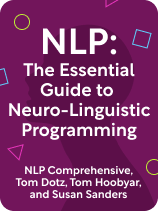

This article is an excerpt from the Shortform book guide to "NLP: The Essential Guide to Neuro-Linguistic Programming" by Tom Hoobyar, Tom Dotz, and Susan Sanders. Shortform has the world's best summaries and analyses of books you should be reading.
Like this article? Sign up for a free trial here.
What does success mean to you? How can you turn your definition of success into achievable goals?
NLP: The Essential Guide to Neuro-Linguistic Programming offers powerful tools to help you clarify your vision and create a path toward your goals. These methods combine mental imagery, sensory awareness, and past experiences to boost your confidence and motivation.
Let’s explore three proven NLP techniques for success that will transform how you approach and achieve your dreams.
NLP Techniques for Success
Success means different things to different people—it may involve adopting new habits, communicating more effectively, achieving career goals, or reaching financial milestones. In NLP: The Essential Guide to Neuro-Linguistic Programming, authors Hoobyar, Dotz, and Sanders suggest that, to achieve success, you first need to be clear about what success means to you.
They explain that a lack of clarity about what you want to achieve creates vague or conflicting sensory representations that prevent you from taking decisive action. And, without a clear target to aim for, you’re more likely to focus on obstacles in your way, creating negative mental associations that hold you back. For example, with a vague goal like “get in shape,” you might hold conflicting images of how you want to look, feel uncertain about which exercises to do, and focus on obstacles like lack of time or energy. Hoobyar, Dotz, and Sanders suggest three NLP techniques for success that will help you clarify and move toward what you want:
- Set clearly defined goals that align with your values and desires.
- Create vivid, detailed mental images of what you want to achieve.
- Recall previous achievements, linking the sensory details to your current goal.
(Shortform note: Tony Robbins (Awaken the Giant Within) echoes the authors’ advice to be clear about what you want. He adds that the more specific you are, the easier it is to imagine the benefits of achieving it—these positive expectations increase your motivation to take proactive steps. Additionally, this clarity helps you devise a detailed plan to prepare for and overcome potential obstacles—allowing you to maintain momentum toward what you want.)
Technique 1: Set Clearly Defined Goals That Align With Your Values & Desires
The authors explain that setting clear goals that align with your values and desires ensures that achieving them will be genuinely fulfilling, increasing your motivation and commitment. For example, if you value your health and enjoy challenges, you might refine the goal to “get in shape” as follows: Run a 5K race in under 30 minutes within the next six months.
(Shortform note: In The 7 Habits of Highly Effective People, Stephen Covey suggests a method for aligning your goals with your values and desires: Picture yourself at the end of your life, looking back at your proudest moments—focus on what you want to achieve in your various roles (parent, spouse, friend, colleague, and so on). This process helps clearly define who you want to be and what you want to achieve in each area of your life, and it encourages you to imagine how life would look after successfully achieving all your goals.)
Technique 2: Create Vivid, Detailed Mental Images of What You Want to Achieve
According to Hoobyar, Dotz, and Sanders, engaging all your senses when envisioning your goal makes it feel more tangible and achievable. They suggest paying particular attention to how good you’ll feel once you’ve achieved your goal, as this will help your brain form positive mental associations that make it easier for you to take action toward your goal. For example, you might imagine the sense of accomplishment and joy you’ll feel as you cross the finish line in a 5K race, the sounds of the cheering crowd, and the sight of your time on the clock.
(Shortform note: While vivid, detailed mental images may make you feel more positive about achieving your goal, research suggests that this practice may also drain the physical energy required to achieve your goals. According to one study, imagining success lowers systolic blood pressure—the force exerted on artery walls when the heart contracts and pushes out blood. Elevated systolic pressure often signifies increased levels of alertness and energy. On the other hand, a drop in systolic blood pressure can lead to lethargy, decreased alertness, and reduced energy, hindering your ability to actively work toward your goals.)
Technique 3: Recall Previous Achievements, Linking the Sensory Details to Your Current Goal
When thinking about your current goal, use the same sensory nuances you focus on when remembering past successes—to achieve this, apply the same method for adopting positive traits (Goal #2). The authors explain that this will encourage your brain to associate the positive sensations from past successes with your current goal, boosting your confidence in your ability to achieve it. For example, recall passing an exam, identifying the feeling of joy when you saw your passing grade, and the sound of your family congratulating you. Then, imagine experiencing these same sensory details—feeling joy and hearing your family cheer you on—as you cross the finish line of your 5K race.
(Shortform note: While recalling previous achievements can boost your confidence, it’s worth noting that your feelings about the past will fluctuate depending on your current mood, due to a phenomenon known as “mood-congruency.” Psychologists explain that you rely on your imagination to construct your memories. However, your emotions and imagination are inextricably linked—meaning that your current emotions determine the emotional content of your recollections. Therefore, ensuring you’re in a good mood before you recall your achievements will help you maximize the benefits of this method.)

———End of Preview———
Like what you just read? Read the rest of the world's best book summary and analysis of Tom Hoobyar, Tom Dotz, and Susan Sanders's "NLP: The Essential Guide to Neuro-Linguistic Programming" at Shortform.
Here's what you'll find in our full NLP: The Essential Guide to Neuro-Linguistic Programming summary:
- How your thoughts form and impact you
- Why it’s difficult to control your thoughts
- The role senses play in your thoughts






